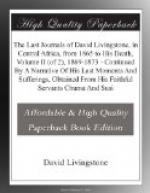Above the fine yellow clay schist of Manyuema the banks of Tanganyika reveal 50 feet of shingle mixed with red earth; above this at some parts great boulders lie; after this 60 feet of fine clay schist, then 5 strata of gravel underneath, with a foot stratum of schist between them. The first seam of gravel is about 2 feet, the second 4 feet, and the lowest of all about 30 feet thick. The fine schist was formed in still water, but the shingle must have been produced in stormy troubled seas if not carried hither and thither by ice and at different epochs.
This Manyuema country is unhealthy, not so much from fever as from debility of the whole system, induced by damp, cold, and indigestion: this general weakness is ascribed by some to maize being the common food, it shows itself in weakness of bowels and choleraic purging. This may be owing to bad water, of which there is no scarcity, but it is so impregnated with dead vegetable matter as to have the colour of tea. Irritable ulcers fasten on any part abraded by accident, and it seems to be a spreading fungus, for the matter settling on any part near becomes a fresh centre of propagation. The vicinity of the ulcer is very tender, and it eats in frightfully if not allowed rest. Many slaves die of it, and its periodical discharges of bloody ichor makes me suspect it to be a development of fever. I have found lunar caustic useful: a plaister of wax, and a little finely-ground sulphate of copper is used by the Arabs, and so is cocoa-nut oil and butter. These ulcers are excessively intractable, there is no healing them before they eat into the bone, especially on the shins.
Rheumatism is also common, and it cuts the natives off. The traders fear these diseases, and come to a stand if attacked, in order to use rest in the cure. “Taema,” or Tape-worm, is frequently met with, and no remedy is known among the Arabs and natives for it.
[Searching in his closely-written pocket-books we find many little mementoes of his travels; such, for instance, as two or three tsetse flies pressed between the leaves of one book; some bees, some leaves and moths in another, but, hidden away in the pocket of the note-book which Livingstone used during the longest and most painful illness he ever underwent lies a small scrap of printed paper which tells a tale in its own simple way. On one side there is written in his well-known hand:—]
“Turn over and see a
drop of comfort found when suffering
from irritable eating ulcers
on the feet in Manyuema,
August, 1870.”
[On the reverse we see that the scrap was evidently snipped off a list of books advertised at the end of some volume which, with the tea and other things sent to Ujiji, had reached him before setting out on this perilous journey. The “drop of comfort” is as follows:—]
“A NARRATIVE OF AN EXPEDITION
TO THE ZAMBESI AND ITS
TRIBUTARIES,
“And the discovery of Lakes Shirwa and Nyassa.




